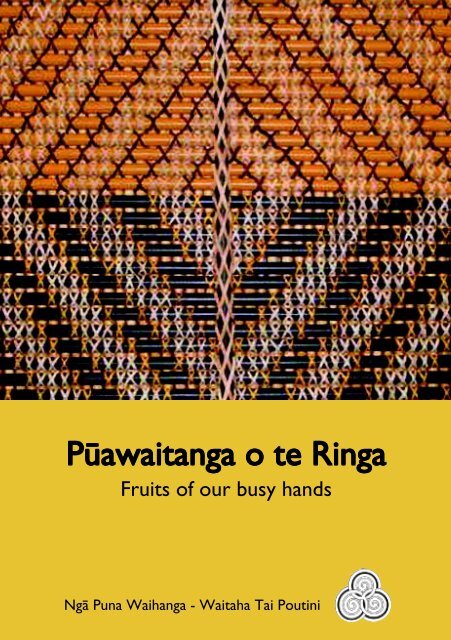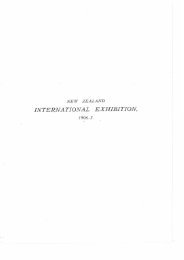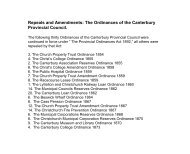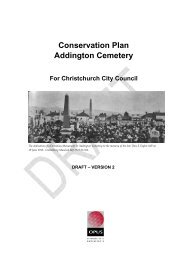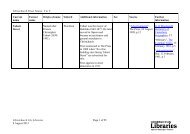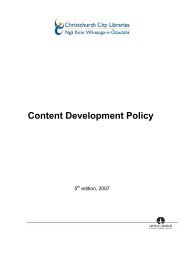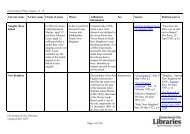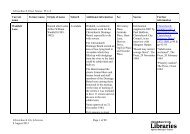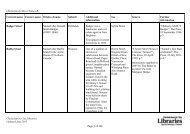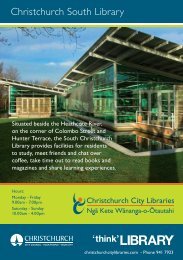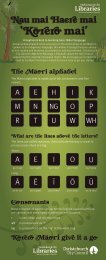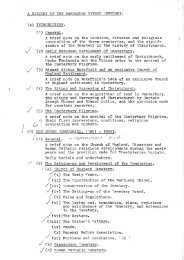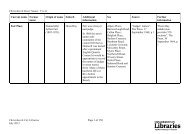Puawaitanga o te Ringa - Christchurch City Libraries
Puawaitanga o te Ringa - Christchurch City Libraries
Puawaitanga o te Ringa - Christchurch City Libraries
Create successful ePaper yourself
Turn your PDF publications into a flip-book with our unique Google optimized e-Paper software.
Püawaitanga Püawaitanga o o <strong>te</strong> <strong>te</strong> <strong>Ringa</strong><br />
<strong>Ringa</strong><br />
Fruits of our busy hands<br />
Ngä Puna Waihanga - Waitaha Tai Poutini
To everyone who worked on this project we warmly express our thanks to you all for the<br />
wairua and manaakitanga generously given to breathe life into the Ngä Pounamu Mäori<br />
Centre on the 2 nd floor in <strong>Christchurch</strong> Central <strong>City</strong> Library Tihei Mauri Ora!<br />
This booklet was compiled by Rhonda Thomson and Patricia Wallace, with photographs<br />
and additional ma<strong>te</strong>rial from staff at <strong>Christchurch</strong> Wa<strong>te</strong>rways, <strong>Christchurch</strong> <strong>City</strong> <strong>Libraries</strong><br />
and members of Ngä Puna Waihanga.<br />
Editor: Patricia Wallace<br />
Assistant Editor: Haneta Pierce<br />
Te Reo Editor: Nekerangi Paul<br />
ISBN 0-908868-23-5<br />
Published by<br />
<strong>Christchurch</strong> <strong>City</strong> <strong>Libraries</strong><br />
<strong>Christchurch</strong> New Zealand, 2003<br />
This community project was facilita<strong>te</strong>d by Ngä Puna Waihanga, Waitaha - Tai Poutini with<br />
funding assistance from Creative New Zealand Creative Communities, <strong>Christchurch</strong> <strong>City</strong><br />
Council and <strong>Christchurch</strong> <strong>City</strong> <strong>Libraries</strong>.
Püawaitanga<br />
Püawaitanga<br />
o o <strong>te</strong><br />
<strong>te</strong><br />
<strong>Ringa</strong><br />
<strong>Ringa</strong><br />
Fruits of our busy hands<br />
Püawaitanga Püawaitanga Püawaitanga Püawaitanga Püawaitanga o o o o o <strong>te</strong> <strong>te</strong> <strong>te</strong> <strong>te</strong> <strong>te</strong> <strong>Ringa</strong> <strong>Ringa</strong> <strong>Ringa</strong> <strong>Ringa</strong> <strong>Ringa</strong> - - - - - fruits fruits fruits fruits fruits of of of of of our our our our our busy busy busy busy busy hands hands hands hands hands is the name given to the series of<br />
tukutuku panels that were specially woven as a community project for the new<br />
Ngä Pounamu Mäori Centre which was crea<strong>te</strong>d as a result of the 2001-02<br />
refurbishment of the <strong>Christchurch</strong> Central <strong>City</strong> Library.<br />
1
2<br />
Püawaitanga Püawaitanga Püawaitanga o o <strong>te</strong> <strong>te</strong> <strong>Ringa</strong><br />
<strong>Ringa</strong><br />
E ngä tïpuna o <strong>te</strong> mahi raranga,<br />
Kotui, tukutuku, tënä koutou.<br />
Tënei ä koutou tamariki<br />
e whai ana i ngä tapuae o Hine-<strong>te</strong> iwaiwa.<br />
Tiakina mai,<br />
ärahina mai mätou<br />
e kimi nei i <strong>te</strong> mätauranga<br />
i waiho i a koe hei taonga mö <strong>te</strong> ao.<br />
L.H.<br />
Helen Helen Tabak<br />
Tabak<br />
It was the wish of Ngä Puna Waihanga member, Helen Tabak, to learn how<br />
to weave tukutuku that had initially star<strong>te</strong>d this project. She took a vital part<br />
in the whole process, giving her own particular expertise to its development.<br />
Her enthusiasm and her contribution were essential parts of the undertaking.<br />
It was therefore a devastating shock to all who had worked with her to<br />
discover that she chose to end her own life in April 2002. Her decision<br />
seemed incomprehensible, and her colleagues were additionally disappoin<strong>te</strong>d<br />
that she did not see the ‘fruits’ of her labours. She was remembered with<br />
great sadness when the panels were officially unveiled, and one, Ngä Heke<br />
Iho, was dedica<strong>te</strong>d to her memory. Nö reira, haere atu rä e hoa aroha, haere<br />
ki <strong>te</strong> pö, haere, haere, haere.
Con<strong>te</strong>nts<br />
Con<strong>te</strong>nts<br />
Tradition of Tukutuku 4<br />
Ngä Puna Waihanga 5<br />
Janet S<strong>te</strong>wart Reserve 6<br />
The Inception of the Project 8<br />
Central <strong>City</strong> Library 9<br />
Community Arts Funding 9<br />
The Organizing Team 10<br />
The Design Process 11<br />
Plan Implementation 12<br />
Püawaitanga o <strong>te</strong> <strong>Ringa</strong> 14 & 15<br />
Inviting Participation and Registration 16<br />
Queen’s Birthday Wänanga 17<br />
Personal Comments and Pictures 18<br />
Follow up and Completion 22<br />
Blessing and Storage 23<br />
Blessing and Naming 24<br />
Project Completion 25<br />
Names of the Volun<strong>te</strong>ers 26 & 27<br />
Stories of the Pat<strong>te</strong>rns 28 & 29<br />
Figure Figure Figure 1: 1: Janet Janet S<strong>te</strong>wart S<strong>te</strong>wart Reserve<br />
Reserve<br />
3
The The Tradition Tradition Tradition of of of Tukutuku<br />
Tukutuku<br />
Tukutuku panels are a traditional Mäori art form. They are decorative wall panels that were<br />
once part of the traditional wall construction used inside meeting houses. Originally tukutuku<br />
were made by creating a latticework of vertically and horizontally placed dried stalks of<br />
käkaho, the creamy-gold flower stalks of toetoe grass, and käkaka, long straight fern stalks,<br />
or wooden laths of rimu or tötara, called variously kaho tara, kaho tarai or arapaki.<br />
These panels were lashed or stitched together. This was done by people working in pairs<br />
from either side, using the rich yellow strands of pïngao, pïngao, pïngao, whi<strong>te</strong> bleached or black-dyed<br />
kiekie, kiekie, kiekie, and sometimes harakeke, harakeke, to crea<strong>te</strong> a range of intrica<strong>te</strong> and artistic pat<strong>te</strong>rns. Stitches<br />
were combined to form a variety of pat<strong>te</strong>rns. Groups of single stitches crea<strong>te</strong>d pat<strong>te</strong>rns<br />
such as tapuae tapuae kautuku kautuku kautuku, kautuku kautuku waewae waewae waewae pakura pakura pakura, pakura pakura whakarua whakarua kopito kopito and papakirango papakirango papakirango. papakirango papakirango Some of the<br />
traditional cross stitched pat<strong>te</strong>rns are poutama poutama, poutama waharua waharua, waharua purapura purapura whetu whetu or mangaroa mangaroa, mangaroa<br />
kaokao kaokao kaokao, kaokao kaokao pätikitiki pätikitiki, pätikitiki roimata roimata roimata toroa toroa and niho niho taniwha taniwha. taniwha In some situations, a central vertical<br />
stake, tumatahuki tumatahuki, tumatahuki tumatahuki was lashed to the panel to aid its strength and stability.<br />
This method of construction crea<strong>te</strong>d a warm, insulating type of decorative wallboard. La<strong>te</strong>r,<br />
pain<strong>te</strong>d wooden slats or half-rounds were used for the horizontal element. Today, however,<br />
such dry flammable wallboards would fail to meet modern building regulations, and they<br />
are no longer used in construction. When used nowadays, tukutuku panels are crea<strong>te</strong>d for<br />
their aesthetic appeal and attached to structurally approved building ma<strong>te</strong>rials.<br />
But like many Mäori arts, the art of tukutuku came perilously close to being lost. In 1916,<br />
Apirana Ngata could find only one practicing carver left on the East Coast, Hone Ngatoto.<br />
As the result of Ngata’s concerns, the Mäori Arts and Crafts Act was passed in 1926, and<br />
the Board of Mäori Arts was established. This led to the founding of the Mäori School of<br />
Art in Rotorua.<br />
The School was based on a number of principles, which included the following:<br />
1. That the artistic genius of the Mäori still survives.<br />
2. That its present expression must be in <strong>te</strong>rms of its present environment.<br />
3. That new applications and ma<strong>te</strong>rials will not lead to the production of un-Mäori works<br />
of art, given the right method of instruction.<br />
Ngata’s work led to a great revival of Mäori building and carving, which led in turn to the<br />
revitalisation of tukutuku weaving. His specific in<strong>te</strong>rest in tukutuku was such that he designed<br />
panels himself.<br />
Sir Apirana Ngata demanded the very highest standards for tukutuku work. Only the best<br />
ma<strong>te</strong>rials and meticulously careful weaving were good enough. It was said that if his eagle<br />
eye picked out any mistakes, “he would cut it [the weaving] with his pocket knife” and the<br />
weavers would have to start over again. 1<br />
4<br />
1 Arapera Whaanga of Wairoa, refer Ta Apirana: nga taonga tuku.
The art of tukutuku weaving is still at risk. It is a time-consuming craft that demands<br />
patience and persis<strong>te</strong>nce. The panels pictured here were produced for the new Mâori<br />
Resource space at the Central <strong>City</strong> Library in a community funded project facilita<strong>te</strong>d by<br />
members of Ngä Puna Waihanga Waitaha Tai Poutini. They represent about 900 hours<br />
work undertaken by more than 180 volun<strong>te</strong>ers during the year 2001. In all their tukutuku<br />
wänanga.<br />
P.W.<br />
Ngä Ngä Puna<br />
Puna<br />
Waihanga<br />
Waihanga<br />
endeavoured endeavoured to<br />
to<br />
maintain maintain the<br />
the<br />
standards standards of of Sir<br />
Sir<br />
Apirana Apirana Ngata.<br />
Ngata.<br />
Ngä Puna Waihanga is the national body of Mäori Artists and Wri<strong>te</strong>rs. Initially formed at<br />
Te Kaha in 1973, it is the tuakana röpü, the oldest and most widespread Mäori arts group<br />
in New Zealand. Amongst the 200 participants of the first hui convened by Hone Tuwhare<br />
were Rangimarie He<strong>te</strong>t, Charles Bennett, Buck Nin, Ralph Ho<strong>te</strong>re, Selwyn Muru, Rei Hamon,<br />
Para Matchitt, Kura Rewiri, Tui Zanetich, Micky Wairoa, Paul Ka<strong>te</strong>ne, Rowley Habib, Dun<br />
Mihaka, Witi Ihimaera, Dinah Rawiri, Rose Denness, Ngahuia Rawiri, Roka Paora, Mana<br />
Cracknell, Ivan Wirepa, Donna Awa<strong>te</strong>re, John Taiapa, Tuti Tukaokao, Bub Wehi, Elizabeth<br />
Murchie, Val Irwin, Syd and Hana Jackson, Sonny Waru, Haare Williams, Don Solomon,<br />
Paul Manu, Mihi Roberts, Bill Tawhai, Malta Sydney and Dr Douglas Sinclair, Cliff Whiting,<br />
Witi Ihimaere and Hirini Melbourne. 1 Other founding members who still support the<br />
organisation in 2002 include Diggeress <strong>te</strong> Kanawa, Cath Brown, and Trixie Menzies.<br />
A number of regional groups were formed, including the local one – Ngä Puna Waihanga<br />
Waitaha Tai Poutini. Over the years, the Ngä Puna Waihanga organisation moun<strong>te</strong>d<br />
exhibitions and published books, while various districts hos<strong>te</strong>d annual national hui and<br />
regional wänanga or workshops.<br />
At provincial level, with Ngäi Tahu artist Cath Brown leading the rohe, a variety of wänanga<br />
have been held that include raranga, taniko, köwhaiwhai, ceramics, waiata, book illustrating,<br />
along with other forms of art. In 1995 the local group undertook its first community<br />
project, creating a multi-media mural at Burnham School. La<strong>te</strong>r in the year, a second multimedia<br />
work was produced for Hagley Community College. In 1998, a series of whäriki<br />
panels was woven for the Riki Te Mairaki Taiaroa Ellison Room at the University of<br />
Can<strong>te</strong>rbury. The creation of tukutuku panels for the Library was a continuation of this<br />
practice of gifting Mäori art to the community of <strong>Christchurch</strong>.<br />
P.W.<br />
1 Te Ao Hou No 74, Nov 1973.<br />
5
Janet Janet Janet S<strong>te</strong>wart S<strong>te</strong>wart Reserve<br />
Reserve<br />
The Janet S<strong>te</strong>wart Reserve is a renewed source of traditional Mäori weaving ma<strong>te</strong>rials. It<br />
borders the Lower Styx River and covers an area of just over two hectares. In 1993, on the<br />
death of landowner Edward S<strong>te</strong>wart, the area was gif<strong>te</strong>d to the <strong>Christchurch</strong> <strong>City</strong> Council.<br />
S<strong>te</strong>wart’s will contained instructions that the farmland be conver<strong>te</strong>d into a reserve that<br />
would be named in memory of his mother, Janet S<strong>te</strong>wart. Historically this landscape formed<br />
a natural part of the Styx River floodplain, and was covered in native vegetation species -<br />
ferns, tussocks and raupö swamp. At the time of the gifting into Council ownership, the<br />
land was a reasonably low lying grassy paddock with a boxed drain running through it.<br />
Figure Figure 2 2 Planting Planting Plan Plan at at Janet Janet S<strong>te</strong>wart S<strong>te</strong>wart Reserve<br />
Reserve<br />
The initial stage of the project saw the creation of a landscape design that was <strong>te</strong>s<strong>te</strong>d by<br />
public consultation. The concept recognised the reserve’s important relationship to the<br />
Styx River and its high natural values associa<strong>te</strong>d with the wa<strong>te</strong>rway. The public consultation<br />
process involved distributing pamphlets, outlining the concept plan, and organising<br />
public meetings with people to review the design plan in detail and discuss the concepts and<br />
relevant issues.<br />
The final form of the Reserve evolved to include the creation of a lake, jetty, walkways and car<br />
park. Native plantings were used to provide a habitat feature for the reserve. The boxed<br />
wa<strong>te</strong>rway was released to form a large pond that was surrounded by riparian planting. The<br />
council also worked closely with Te Korari and Landcare Research in the planting of a pä<br />
harakeke - a plan<strong>te</strong>d area of special flaxes and toetoe suitable for traditional Mäori weaving.<br />
6
Eventually, this reserve will be linked with the Malvern Scout Group redevelopment project<br />
that is loca<strong>te</strong>d to the north-east of Janet S<strong>te</strong>wart Reserve.<br />
The scale of the project meant the development process needed to be spread over a six year<br />
period. Community planting days were organised by the <strong>Christchurch</strong> <strong>City</strong> Council, the<br />
Malvern Scout Group and Te Korari. Native vegetation species such as the toetoe and<br />
harakeke were grouped into large plots for maximum visual effect. The work was achieved<br />
in partnership with the S<strong>te</strong>wart family, <strong>Christchurch</strong> <strong>City</strong> Council, Burwood/Pegasus<br />
Community Board, Waiora Trust, Landcare Research, Te Korari, the Malvern Scout Group,<br />
The Guardians of the Styx and members of the wider local community.<br />
The results of the project are many and varied:<br />
Ecology Improved wildlife habitat for birds and aquatic organisms<br />
Heritage Recognition of the S<strong>te</strong>wart family through reserve name<br />
Preservation of exotic tree species that provided the original stake for the<br />
farmhouse food safe.<br />
Cultural Re-vegeta<strong>te</strong>d raw plants now supply ma<strong>te</strong>rials for traditional Mäori weaving,<br />
e.g. Pä harakeke plantings at the Marshland Road / Lower Styx crossing<br />
Landscape Improved viewing access to the river with enhanced views of native<br />
vegetation plantings<br />
Recreation Grea<strong>te</strong>r access to the Styx River for recreational activities such as picnicking,<br />
walking and boating (with jetty)<br />
Drainage Flood storage maintained<br />
Improved stability of riverbank<br />
Enhanced wa<strong>te</strong>r quality en<strong>te</strong>ring Styx River from Gibsons Drain<br />
Figure Figure 3: 3: Käkaho Käkaho harves<strong>te</strong>rs harves<strong>te</strong>rs at at Janet Janet S<strong>te</strong>wart S<strong>te</strong>wart Reserve, Reserve, Reserve, March March March 2001<br />
2001<br />
R.C.<br />
7
The The Inception Inception of of of the the the Project<br />
Project<br />
Nau mai, Haere mai<br />
Ki Ki <strong>te</strong> <strong>te</strong> whänau whänau Rutherford<br />
Rutherford<br />
Saturday Saturday 10 10 February February 2001, 2001, 12.30pm<br />
12.30pm<br />
beginning beginning beginning with with shared shared lunch lunch<br />
lunch<br />
BRING:<br />
• kai to share • ideas for Wänanga • requests and information<br />
• your diaries • your subs and yourselves<br />
We want to plan our programme for the year<br />
A notice in the January 2001 Ngä Puna Waihanga Waitaha Tai Poutini newslet<strong>te</strong>r called<br />
members to a hui to plan the programme for the year. Unbeknown to the members who<br />
at<strong>te</strong>nded, this first hui of the year was to be the catalyst for the tukutuku project. Among<br />
those members present were Simon Rutherford, Helen Tabak, Mae Taurua and Patricia<br />
Wallace.<br />
Simon talked about the resources of the Janet S<strong>te</strong>wart Reserve and how well the harakeke<br />
and toetoe had grown. Hearing of the toetoe promp<strong>te</strong>d Helen to express her keen in<strong>te</strong>rest<br />
to learn how to weave tukutuku panels. Mae took up the wero and said that she could<br />
<strong>te</strong>ach us the process. Patricia reminded members that the group had undertaken a variety<br />
of community projects in the past (namely, a multimedia mural for the Whare Haupiri at<br />
Burnham School, a second work entitled Te Tiwhana a Kahukura for Hagley Community<br />
College in 1995, and whariki panels for Te Mairoa in the Maori Department at the University<br />
of Can<strong>te</strong>rbury in 1998). It was generally agreed that the creation of a tukutuku panel might<br />
make another suitable community project that could be given to the city of <strong>Christchurch</strong>.<br />
Almost within days, the group learned through Community Arts Co-ordinator Rhonda<br />
Thomson that Haneta Pierce, Mäori Library Services Co-ordinator at <strong>Christchurch</strong> <strong>City</strong><br />
<strong>Libraries</strong>, was hoping to incorpora<strong>te</strong> some tukutuku work in the proposed new Mäori<br />
space currently in plan there.<br />
A mini kömiti consisting of the <strong>te</strong>chnical advisor Mae, Helen, Tania Nutira and Patricia met<br />
on si<strong>te</strong> with Rhonda, Haneta and Caroline Syddall to look at various options. They were<br />
enthusiastic about the possibilities. As soon as they saw the proposed space with its<br />
rectangular concre<strong>te</strong> pillars, they knew that one tukutuku panel was not going to be<br />
appropria<strong>te</strong>. They immedia<strong>te</strong>ly agreed that the space should have panels around the tops<br />
of each of the pillars. They could also see the po<strong>te</strong>ntial for this to develop into a much<br />
wider community project, putting a strong mark of Mäori ownership on the area. The<br />
group embarked on feasibility studies, quantity surveying, cost assessment and availability<br />
of resources while also at<strong>te</strong>mpting to gauge the likely level of community in<strong>te</strong>rest.<br />
8
The The Central Central <strong>City</strong> <strong>City</strong> Library<br />
Library<br />
The Central <strong>City</strong> Library moved to the present si<strong>te</strong> in Glouces<strong>te</strong>r Street in 1982, and the<br />
planned refurbishment of 2001-2 was motiva<strong>te</strong>d by a desire to crea<strong>te</strong> more inviting and<br />
comfortable public spaces. This was partly in response to the progression of library services<br />
from merely holding books and information in familiar conventional formats, to<br />
the incorporation of ma<strong>te</strong>rial in videotape, photographic and pictorial forms and a range of<br />
electronic sources.<br />
The development of the new Ngä Pounamu Mäori o Ao<strong>te</strong>aroa area provided a space<br />
substantially larger than the previous Ngä Taonga Mäori area, in addition to providing staff<br />
dedica<strong>te</strong>d to helping people find Mäori information plus lis<strong>te</strong>ning posts, video viewing facilities,<br />
lounge chairs, study space and a range of Mäori ma<strong>te</strong>rial . From the early planning stages of<br />
this area the Mäori Resource Staff, Ngä Puna Waihanga members and contrac<strong>te</strong>d archi<strong>te</strong>ctural<br />
and other design staff worked together to incorpora<strong>te</strong> the tukutuku panels into this area,<br />
with scores of meetings, phone calls, faxes and emails.<br />
C.S. and C.T.<br />
Community Community Arts Arts Arts Funding<br />
Funding<br />
Figure Figure 4: 4: Early Early planning<br />
planning<br />
meeting meeting at at at the the Library<br />
Library<br />
Figure Figure 5: 5: Ongoing Ongoing planning<br />
planning<br />
Key financial suppor<strong>te</strong>rs included Creative Communities and the <strong>Christchurch</strong> <strong>City</strong> Council.<br />
Creative Communities is a Creative New Zealand arts and crafts funding scheme<br />
adminis<strong>te</strong>red locally throughout New Zealand. Ngä Puna Waihanga Waitaha Tai Poutini<br />
was successful in its application and received two thousand and forty four dollars. The<br />
<strong>Christchurch</strong> <strong>City</strong> Council gran<strong>te</strong>d one thousand dollars.<br />
R.T.<br />
9
The The Organising Organising Organising Team<br />
Team<br />
An important element in the success of the tukutuku project was the ongoing <strong>te</strong>amwork that<br />
was evident while the panels were in process. Although each <strong>te</strong>am member had her special<br />
roles, they consul<strong>te</strong>d each other regularly and maintained an effortless consensus that was<br />
both harmonious and energising. Each woman contribu<strong>te</strong>d her own particular talents:<br />
Figure Figure 6: 6: 6: Mae, Mae, Mae, Haneta, Haneta, Helen, Helen, Patricia Patricia and and and Rhonda<br />
Rhonda<br />
Haneta Haneta Pierce<br />
Pierce<br />
Haneta was born and raised in <strong>Christchurch</strong>, but affilia<strong>te</strong>s to Ngäti Mutunga (Chatham<br />
Islands) where her father Les Black was born and raised. As the Mäori Services Co-ordinator<br />
Haneta seized the chance to make a difference and crea<strong>te</strong> a Mäori presence in the<br />
<strong>Christchurch</strong> <strong>City</strong> <strong>Libraries</strong> network. It was Haneta who had the initial vision and who<br />
facilita<strong>te</strong>d in<strong>te</strong>raction between the Library personnel and Ngä Puna Waihanga through to<br />
completion of the tukutuku project, culminating in a blessing and unveiling ceremony for<br />
the panels in Ngä Pounmau Mäori Centre, on the second floor at the Central <strong>City</strong> Library.<br />
Helen Helen Helen Kuitanga Kuitanga Tabak Tabak Tabak Tabak (1966-2002). Of Kahungunu descent, Helen grew up in <strong>Christchurch</strong><br />
with little access to her cultural background. Despi<strong>te</strong> this, she showed a strong Mäori<br />
perspective in her thinking and her work. In 1999 she joined Ngä Puna Waihanga, where<br />
she soon showed her creative and organisational talents. In 2000 she comple<strong>te</strong>d her Diploma<br />
in In<strong>te</strong>rior Design at <strong>Christchurch</strong> Poly<strong>te</strong>chnic. Her special contributions to the tukutuku<br />
project planning included organising framing ma<strong>te</strong>rials, quantities, and specialist locations<br />
for wänanga, and co-ordinating public relations.<br />
Mae Mae Taurua Taurua (Ngäti Pamoana) grew up in the Wanganui Region. In 1977 she joined the<br />
<strong>Christchurch</strong> Branch of the Mäori Womens’ Welfare League. The League assis<strong>te</strong>d the<br />
survival of traditional Mäori crafts by holding national competitions. Keen to learn tukutuku,<br />
Mae had to experiment and <strong>te</strong>ach herself to weave. From 1978 to 1990 she regularly won<br />
first place at League national level competition. A few years la<strong>te</strong>r, at Koriniti Marae she led<br />
a <strong>te</strong>am of 70 people weaving 30 panels to refurbish the old Poutama house in just 17 days.<br />
Her weaving is found throughout the community; at Woolston School whare, Te Wai<br />
Pounamu Chapel, Anglican Care House, and the <strong>Christchurch</strong> Cathedral to name a few<br />
locations. Having shared her weaving expertise for so many years, Mae was the obvious<br />
choice of tutor for this project.<br />
10
Rhonda Rhonda Thomson Thomson (Käi Tahu, Käti Waewae). Working as an Arts Advisor - Mäori and<br />
Cultural at the <strong>Christchurch</strong> <strong>City</strong> Council, Rhonda joined NPW 2000. Rhonda provided<br />
the in<strong>te</strong>rface between <strong>Christchurch</strong> <strong>City</strong> Council and community volun<strong>te</strong>ers. Her expertise<br />
ensured that Ngä Puna Waihanga followed requisi<strong>te</strong> procedures to the let<strong>te</strong>r, so that<br />
applications for funding were appropria<strong>te</strong>ly targe<strong>te</strong>d and ultima<strong>te</strong>ly successful.<br />
Patricia Patricia Wallace Wallace (Ngäti Porou) grew up in <strong>Christchurch</strong>, without access to her cultural<br />
heritage. A former <strong>te</strong>acher, Tricia joined Ngä Puna Waihanga in 1993 while studying Mäori<br />
art history at the University of Can<strong>te</strong>rbury, and since 1995 has represen<strong>te</strong>d the Waitaha<br />
Tai Poutini region at national level. In 1996 she gradua<strong>te</strong>d B.A. (Hons) in Mäori and B.A. in<br />
Art History, with an emphasis on Mäori and Pacific arts; in 2002 she submit<strong>te</strong>d her Ph.D.<br />
thesis on traditional Mäori dress. Patricia’s role was research and planning of tukutuku<br />
designs, liaison with school and community groups, co-ordination of personnel and ensuring<br />
project continuity.<br />
The The Design Design Process<br />
Process<br />
Planning the pat<strong>te</strong>rns for nine<strong>te</strong>en different panels was an enormous but rewarding task.<br />
Despi<strong>te</strong> her years of experience, tutor Mae Taurua stood back to give the newcomers a<br />
free hand. Because the panels were to go in a Mäori resource area, it seemed appropria<strong>te</strong><br />
that the designs should provide another form of resource. It was decided to use conventional<br />
ma<strong>te</strong>rials, a colour palet<strong>te</strong> of earthy tones and to incorpora<strong>te</strong> a variety of traditional designs.<br />
Planning star<strong>te</strong>d by researching many sources as possible. Inspiration came from whare nui<br />
(meeting houses) and their dining halls (whare kai) and churches around the country such<br />
as Te Hau Ki Turanga at Te Papa, Te Hono Ki Rarotonga and Hine-Matikotai of Pakirkiri<br />
Marae, Te Whatu-Manawa Maoritangi O Rehua at Rehua Marae, Aoraki at Ngä Hau E Whä<br />
National Marae, St Faiths of Ohinemutu, the church at Putiki, the chapel and hospital of<br />
Gisborne Hospital, the chapel and the old hos<strong>te</strong>l of Te Wai Pounamu College, and from a<br />
range of published sources.<br />
Variations of traditional pat<strong>te</strong>rns that would show the creativity and diversity of the art<br />
form were chosen, with no two panels to be the same. The major pat<strong>te</strong>rns that allowed<br />
this development were poutama poutama, poutama the s<strong>te</strong>pped pat<strong>te</strong>rn of Ngäti Porou; roimata roimata, roimata the pat<strong>te</strong>rn<br />
based on the legend of albatross <strong>te</strong>ars; kaokao kaokao, kaokao the pat<strong>te</strong>rns of ribs or arms of warriors;<br />
niho niho taniwha taniwha, taniwha the wa<strong>te</strong>r-mons<strong>te</strong>r’s tooth; pütikitiki pütikitiki, pütikitiki based on the flounder; and mumu mumu, mumu the<br />
rectangular design from the Whanganui region. Other traditional designs included waharua waharua, waharua<br />
the double mouth; and purapura purapura whetu, whetu, the star seeding pat<strong>te</strong>rn. A special design<br />
incorporating the mountain Aoraki was crea<strong>te</strong>d to acknowledge the tangata whenua, Ngäi<br />
Tahu (see over page).<br />
The designs were planned on Excel spread sheets, which allowed the pat<strong>te</strong>rns to be centred<br />
and balanced. This sys<strong>te</strong>m enabled the adjustment of the number of kakaho to provide<br />
even or uneven numbers as each design required, and facilita<strong>te</strong>d planning the use of colours.<br />
P.W.<br />
11
Plan Plan Plan Implementation<br />
Implementation<br />
Implementation<br />
Figure Figure Figure 7: 7: Excel Excel spread spread sheet sheet planning planning of of of tukutuku tukutuku pat<strong>te</strong>rn<br />
pat<strong>te</strong>rn<br />
The first two wänanga (workshops) for the project were held at the Janet S<strong>te</strong>wart Reserve.<br />
Members of Ngä Puna Waihanga were taught how to identify and harvest the tall käkaho<br />
stalks of the toetoe.<br />
The stalks were all trimmed at the si<strong>te</strong>, the flower heads returned to the soil and the<br />
käkaho stacked and taken away to dry naturally by standing in an airy space, in preparation<br />
for fitting into the frames.<br />
12<br />
Figure Figure 8: 8: Harvesting Harvesting toetoe<br />
toetoe
Between 24 April and 8 May, five workshops were organised at the Sullivan Avenue si<strong>te</strong> of<br />
<strong>Christchurch</strong> Poly<strong>te</strong>chnic to build the frames for the tukutuku panels, with the assistance of<br />
Applied Technology Course Supervisor, Gary Ashby.<br />
Frames were cut and shaped from lengths of timber, mitred, glued and stapled, and sanded<br />
ready for the second stage, that of inserting half round timber slats. Af<strong>te</strong>r experimenting,<br />
a <strong>te</strong>mpla<strong>te</strong> was devised to assist with even spacing and the half rounds were also glued<br />
and stapled.<br />
Then the prepared frames were pain<strong>te</strong>d, the surrounds black, the half rounds in combinations<br />
of red ochre, yellow ochre and black with paint that was kindly dona<strong>te</strong>d by Benjamin Moore’s<br />
Wrights Road Store.<br />
The next stage was tying the dried käkaho into the frames at one of many wänanga that were<br />
held in Mae Taurua’s garage. The käkaho were lashed vertically, at right angles behind the<br />
pain<strong>te</strong>d half rounds. They had to comprise even or odd numbers, according to their in<strong>te</strong>nded<br />
weaving pat<strong>te</strong>rn. Supplies of weaving fibre were gathered; some of the whi<strong>te</strong> kiekie was dyed<br />
black, some was retained whi<strong>te</strong>, and golden pîngao grass was collec<strong>te</strong>d in readiness.<br />
Figure Figure 9: 9: 9: Frame Frame making making workshop workshop<br />
workshop<br />
Figure Figure Figure 10: 10: 10: Learning Learning Learning to to lash lash lash the the käkaho käkaho into into the the frames frames<br />
frames<br />
13
14<br />
Püawaitanga Püawaitanga o o <strong>te</strong> <strong>te</strong> <strong>Ringa</strong><br />
<strong>Ringa</strong><br />
Aoraki Aoraki<br />
Poutama Poutama<br />
Poutama Poutama<br />
Double Double Poutama<br />
Poutama<br />
Kaokao Kaokao Kaokao (variation) (variation)<br />
Ngä Ngä Heke Heke Iho Iho Iho<br />
Mumu Mumu<br />
Niho Niho Taniwha<br />
Taniwha<br />
Purapura Purapura Whetü<br />
Whetü<br />
Waharua<br />
Waharua<br />
Roimata<br />
Roimata<br />
Roimata<br />
Roimata<br />
Niho Niho Niho Taniwha Taniwha (variation)<br />
(variation)<br />
Roimata Roimata Turuturu<br />
Turuturu<br />
Pororangi Pororangi Poutama Poutama<br />
Kaokao<br />
Kaokao<br />
(variation) Pätiki<br />
Roimata<br />
Roimata<br />
Roimata (variation) (variation)<br />
(variation)<br />
This community project was proudly sponsored by: Ngä Puna Waihanga - Waitaha Tai Poutini, <strong>Christchurch</strong> <strong>City</strong> <strong>Libraries</strong>, <strong>Christchurch</strong> <strong>City</strong> Council & CNZ Creative New Zealand.<br />
Pätiki Pätiki<br />
Pätiki<br />
Pätiki (variation)<br />
(variation)<br />
Püawaitanga Püawaitanga o o <strong>te</strong> <strong>te</strong> <strong>Ringa</strong><br />
<strong>Ringa</strong><br />
Fruits Fruits of of our our busy busy hands<br />
hands<br />
Co-ordina<strong>te</strong>d by Ngä Puna<br />
Waihanga - Waitaha Tai Poutini<br />
March March 2001 2001 - - May May May 2002<br />
2002<br />
Acrylic, wood, käkaho, kiekie, pingao<br />
8 panels 450 x 850mm<br />
11 panels 550 x 850mm<br />
15
Inviting Inviting Participation Participation and and Registration<br />
Registration<br />
Mindful that there were not enough weavers in the small membership of the local Ngä Puna<br />
Waihanga branch for the project, it was decided to approach community groups and school<br />
whänau to ascertain possible in<strong>te</strong>rest levels. Notices were sent out to various schools<br />
from Rangiora to Cashmere, from Lincoln to Aranui, inviting their participation; while<br />
community would-be-weavers were invi<strong>te</strong>d to participa<strong>te</strong> through an advertisement in Ngäi<br />
Tahu Newlet<strong>te</strong>r and through the Ngä Puna Waihanga newslet<strong>te</strong>r. For two months, through<br />
April and May, Helen and Patricia –sometimes together, sometimes independently - at<strong>te</strong>nded<br />
meetings and initia<strong>te</strong>d negotiations with possible partners. Finally, whänau from Hagley<br />
Community College, Lincoln High School, Avonside Girls High School, <strong>Christchurch</strong><br />
Poly<strong>te</strong>chnic and Aorangi Primary School made commitments to work on panels, along with<br />
other wider whänau groups. Although a community project, participants were required to<br />
pay for the workshop, as community funding requires financial input from applicants.<br />
16<br />
Registration for forth coming Wänanga 2nd/3rd 2nd/3rd June June 2001,<br />
2001,<br />
Wänanga Wänanga Tukutuku Tukutuku at at <strong>Christchurch</strong> <strong>Christchurch</strong> Central Central <strong>City</strong> <strong>City</strong> Library, Library, with with Mae Mae Taurua,<br />
Taurua,<br />
$20.00 members (2 days) $40.00 non-members (2 days)<br />
(Places are limi<strong>te</strong>d so regis<strong>te</strong>r now – before you miss out)<br />
Please accept my Annual subscription and/or registration for the wänanga<br />
as marked above.<br />
My Subscription $ _____________<br />
Registration fee tukutuku wananga: $ _____________<br />
TOTAL: $ _____________<br />
Figure Figure 11: 11: 11: Bringing Bringing the the ma<strong>te</strong>rials ma<strong>te</strong>rials into into into the the Library<br />
Library
Queen’s Queen’s Birthday Birthday Birthday Wänanga<br />
Wänanga<br />
By the weekend of Queen’s Birthday, June 2001, a total of nine<strong>te</strong>en frames were ready for<br />
the weaving wänanga. Transferring the frames and all the ma<strong>te</strong>rials to set up in the library<br />
space the day before the Queen’s Birthday wänanga took some time (see picture previous<br />
page). Five people spent a total of about 14 hours, carrying frames, ‘work-ma<strong>te</strong>s’, buckets<br />
and weaving ma<strong>te</strong>rials from the Farmers Car Park into the Library. Visiting library staff<br />
were amazed at the amount of work that had clearly already taken place.<br />
Figure Figure Figure 12: 12: 12: Mae, Mae, Mae, demonstrating<br />
demonstrating<br />
Figure Figure 13: 13: 13: Working Working together together in in partnership,<br />
partnership,<br />
from from each each side side of of the the panels panels<br />
panels<br />
The preparations for the big wänanga had<br />
been a lot of work but it was worth it.<br />
The ‘workma<strong>te</strong>s’ were ready, buckets of<br />
kiekie were soaking, and all the ma<strong>te</strong>rials<br />
were ready. Af<strong>te</strong>r welcomes, mihi and<br />
karakia, Mae began to demonstra<strong>te</strong> the<br />
weaving process.<br />
Everyone was able to start weaving as<br />
soon as the demonstrations were finished,<br />
and with their spreadsheet plan beside<br />
them, to have a clear idea of what they<br />
were working towards achieving. The<br />
variety happening within the wänanga<br />
made the progress really exciting. Af<strong>te</strong>r<br />
the months of preparation it was a great<br />
experience.<br />
Some of the panels began to take on a<br />
wairua of their own. The Aorangi School<br />
community had specifically wan<strong>te</strong>d to<br />
work on the Aoraki panel. Eventually,<br />
almost every member of the school wove<br />
a few stitches, due entirely to the<br />
commitment of their <strong>te</strong>acher Debra<br />
Posa. Hagley whänau were keen to weave<br />
‘poutama’; they eventually comple<strong>te</strong>d<br />
two panels. The Sutcliffe whänau were<br />
aware of the impending arrival of a new<br />
family addition, while Library staff were<br />
weaving <strong>te</strong>ardrops, mindful of a<br />
<strong>te</strong>rminally ill colleague who actually<br />
passed away during the weekend. Some<br />
panels gave the more artistic individuals<br />
room for their own creativity.<br />
17
18<br />
Personal Personal comments comments from from from some some of of the the participants participants<br />
participants<br />
• • •<br />
“The workshop was<br />
pure beauty….”<br />
• • •<br />
Figure Figure 14: 14: Concentration<br />
Concentration<br />
Concentration<br />
“The workshop was pure beauty. Everyone there came ready and exci<strong>te</strong>d to<br />
learn about weaving. The <strong>te</strong>achers and co-ordinators were so kind and patient<br />
and always willing to help out wherever they were needed and they were so<br />
pleased about all the newcomers. Rebecca and I took our panel back to Lincoln<br />
High School where we hope to comple<strong>te</strong> it, and at the same time pass on the<br />
knowledge from the workshop to others who wish to learn.”<br />
A. D. M.
Figure Figure 15: 15: Karakia Karakia at at at lunch lunch break<br />
break<br />
The place began to buzz and it was difficult to persuade people to break for lunch. Lunches<br />
of cold chicken pieces, finger foods and fruit were provided by the Library, upstairs in the<br />
staff room on both days of the wänanga.<br />
Figure Figure 16: 16: Hard Hard at at work<br />
work<br />
“I not only met a diversity of people and learnt new skills, but this lovely tukutuku weaving<br />
also enabled me to crea<strong>te</strong> a bond with whomever I was partnered with on a tukutuku<br />
panel. We were also well ca<strong>te</strong>red for on the food front with both morning and af<strong>te</strong>rnoon<br />
<strong>te</strong>a, and lunch provided. Overall it was an enriching experience that I was fortuna<strong>te</strong> enough<br />
to partake in. ‘Thankyous’ go out to everyone who made this workshop such a great<br />
success!”<br />
N.S.<br />
“I was amazed by the skillfulness of some in the art of tukutuku and the patience of the<br />
<strong>te</strong>achers. I felt qui<strong>te</strong> emotionally involved in the panel I was helping with; I will always look<br />
at that panel and know many people put it there - <strong>te</strong>amwork. There was a sense of bonding<br />
between everyone. The day was very well organised”.<br />
F.W.<br />
19
Figure Figure 17: 17: Enjoying Enjoying the the work<br />
work<br />
“I responded to Haneta’s call for people in<strong>te</strong>res<strong>te</strong>d in at<strong>te</strong>nding a tukutuku workshop over<br />
Queen’s Birthday weekend with great enthusiasm. It was easy to see the huge amount of<br />
work that had already gone into preparing the frames to the stage where we could start<br />
weaving. The atmosphere in which we were taught was truly nourishing. All our <strong>te</strong>achers<br />
were so willing to share their knowledge and by the end of the day, I really had a sense of<br />
achievement. By the end of the second day I had worked on four different panels. I learned<br />
so much from the skilled weavers I was able to work with, and I was also able to share my<br />
little bit of knowledge with work colleagues. All in all a wonderful two days.”<br />
C.M.<br />
20
Figure Figure 18: 18: Achievement!<br />
Achievement!<br />
“It was a wonderful weekend with a real feeling of community and support. Although I<br />
didn’t do much actual weaving it was great to see everyone working together and progress<br />
being made. I felt a real sense of belonging and of achievement for the few stitches that I<br />
contribu<strong>te</strong>d. I’m really exci<strong>te</strong>d at the thought of the finished panels hanging in the Library<br />
and so many people being able to see what they produced.”<br />
C.S.<br />
21
Follow Follow up up and and Completion<br />
Completion<br />
At the end of the two day wänanga (Monday was excluded), the<br />
weavers dispersed with their panels to continue working on<br />
them at their homes or schools. The first panel to be comple<strong>te</strong>d<br />
was returned by the King whänau, the day af<strong>te</strong>r the long<br />
weekend.<br />
The progress of other panels was monitored by Mae, Helen or<br />
Patricia, who replenished ma<strong>te</strong>rial supplies and ensured that the<br />
work continued or was moved on to the next group of weavers.<br />
Seven weeks la<strong>te</strong>r, all the frames were called in so that weaving demonstrations could be<br />
part of ongoing displays during Mäori Language Week, July 2001, in both the Central <strong>City</strong><br />
Library and the foyer of the Mäori Department at the University of Can<strong>te</strong>rbury.<br />
From this point on, a series of small weaving wänanga kept on happening all around the<br />
place – at the <strong>City</strong> Council Offices with Christine Heremaia’s <strong>te</strong>am, at the Rutherfords’<br />
home, in schools – Hagley, Avonside and also at Girls’ High School, in priva<strong>te</strong> homes, in<br />
groups, at Helen’s place, and as shown, in Mae’s garage. In many cases, there was almost a<br />
party atmosphere amidst the activity.<br />
22<br />
Figure Figure Figure 20: 20: Wänanga Wänanga in in Mae’s Mae’s garage garage<br />
garage
Blessing Blessing Blessing and and Storage<br />
Storage<br />
Figure Figure 21: 21: The The panels panels are are carried carried in in with with karakia<br />
karakia<br />
In August 2001, the panels were virtually comple<strong>te</strong>d, but the Library renovations were well<br />
behind schedule. Rather than leave the panels in priva<strong>te</strong> storage, it was decided to have<br />
them placed in archival storage at the Library. A small but moving ceremony was held on<br />
23 August when the comple<strong>te</strong>d panels were moved into the Library’s storage facility.<br />
Kaumatua Maruhaeremuri Stirling called on the taonga and blessed them before they were<br />
safely ensconced in the archives department, to await the time when they will be hung. It<br />
was an emotional time, particularly for those who had been involved with the project since<br />
its inception.<br />
Figure Figure 22: 22: 22: The The tukutuku tukutuku panels panels panels go go into into archival archival storage<br />
storage<br />
23
Blessing Blessing and and Naming<br />
Naming<br />
It was decided to install the tukutuku panels in their rightful place during Te Wiki o Te Reo<br />
Mäori (Mäori Language Week) 22-27 July 2002. This timing coincided with the new Mäori<br />
name given to the network of <strong>City</strong> <strong>Libraries</strong> - Ngä Ke<strong>te</strong> Wänanga o Ötautahi - transla<strong>te</strong>d as<br />
‘<strong>Christchurch</strong> Baskets of Knowledge and Learning.’ The new name was adop<strong>te</strong>d as part of<br />
the <strong>Libraries</strong>’ commitment to on-going bi-cultural development of services for Mäori.<br />
A blessing and unveiling ceremony for the tukutuku panels was planned in conjunction with<br />
the official launching of the new name on Tuesday 23 July at ‘Ngä Pounamu Mäori Centre’<br />
in the Central <strong>City</strong> Library.<br />
Figure Figure 23: 23: Hagley Hagley Community Community College College members members near near one one of of the the pillars pillars with with its its black black<br />
black<br />
draped draped panels panels (left), (left), and and by by one one of of their their poutama poutama panels panels (right).<br />
(right).<br />
The nine<strong>te</strong>en panels were individually<br />
unveiled by their weavers in a formal<br />
procedure conduc<strong>te</strong>d by the Rev. Maurice<br />
Grey, with the assistance of Maruhaeremuri<br />
Stirling. Members of the Hagley Community<br />
kapahaka group suppor<strong>te</strong>d the occasion with<br />
waiata. Af<strong>te</strong>r the welcome, the ceremony<br />
began at the entrance to Ngä Pounamu Mäori<br />
Centre with the Aoraki panel being<br />
uncovered by students from Aorangi School.<br />
The young people were deligh<strong>te</strong>d when<br />
Maurice Grey joined in with them as they<br />
sang their waiata. The second panel, that<br />
was named for the la<strong>te</strong> Helen Tabak, was<br />
unveiled by members of her whänau.<br />
24<br />
Figure Figure Figure 24 24 24 : : The The ceremony ceremony continues.<br />
continues.
Gradually, the party moved around the room and around each pillar, revealing the panels<br />
and acknowledging the different whänau and groups that had given so much time and energy<br />
in their creation, and celebrating their achievements with waiata. In a move away from the<br />
more usual tradition, the last panel was unveiled by two men in acknowledgement of the<br />
work and support given to the project by a number of men in the community. The ceremony<br />
finished with the sharing of kai in the staff room.<br />
Project Project Completion<br />
Completion<br />
When the ceremony and sharing of kai were over, the members of the project <strong>te</strong>am returned<br />
to Ngä Pounamu Mäori Centre to have a quiet look at the culmination of their efforts. It<br />
was their first chance to see all the panels in situ. They were pleased at the strong Mäori<br />
presence the panels crea<strong>te</strong>d, but felt comple<strong>te</strong>ly overwhelmed by the enormity of what had<br />
been achieved, at the tremendous amount of labour, aroha and goodwill the panels<br />
represen<strong>te</strong>d and the keen sense of community spirit which they engendered.<br />
Figure Figure 25: 25: Project Project comple<strong>te</strong>d comple<strong>te</strong>d – – Rhonda, Rhonda, Haneta, Haneta, Mae Mae and and Patricia.<br />
Patricia.<br />
“As a <strong>te</strong>am, we would like to thank all those members of the community who shared in this<br />
project; those who suppor<strong>te</strong>d our endeavours, who generously gave their time, energy,<br />
their various skills and talents, words and money, to help bring this project to fruition.<br />
Without your efforts, Püawaitanga o <strong>te</strong> <strong>Ringa</strong> would not exist. We hope that people who<br />
view the work in years to come will gain not only the sense of tradition the panels offer but<br />
also of the pleasure they gave to ordinary individuals who worked so hard together. It was<br />
a privilege for us to share in this experience.”<br />
NPW <strong>te</strong>am.<br />
25
The The The volun<strong>te</strong>ers volun<strong>te</strong>ers who who who assis<strong>te</strong>d assis<strong>te</strong>d in in the the creation creation of of of the the Püawaitanga Püawaitanga o o <strong>te</strong> <strong>te</strong> <strong>Ringa</strong> <strong>Ringa</strong><br />
<strong>Ringa</strong><br />
1. Aaron Leith<br />
2. Abbey Taukamo<br />
3. Abi Wightman<br />
4. Adele Sissons<br />
5. Ahra Kim<br />
6. Alana Chuck<br />
7. Alison Rutherford<br />
8. Alyssia Mulqueen<br />
9. Amanda Jackson<br />
10. Amy Maclachlan<br />
11. Amy Sinclair<br />
12. Anahera Smith<br />
13. Anita Bodsworth<br />
14. Ann Winstanley<br />
15. Anne Irwin<br />
16. Anne O’Grady<br />
17. Anne Sutcliffe<br />
18. Anthony<br />
19. Arana<br />
20. Ariyan Noorzai<br />
21. Ashleigh Barclay<br />
22. Ashleigh Pierce<br />
23. Aurora Demon<strong>te</strong><br />
24. Barbara Filmer<br />
25. Barbara Moorehouse<br />
26. Bonnie Pierce<br />
27. Brian Lowson<br />
28. Bridget Allan<br />
29. Carl Webs<strong>te</strong>r<br />
30. Carla Campbell<br />
31. Caroline Syddall<br />
32. Catherine Cooper<br />
33. Catherine Simpson<br />
34. Cathy Thompson<br />
35. Celia Falloon<br />
36. Chantal Thomas<br />
37. Cherie Harris<br />
38. Chris Woods<br />
39. Christine Brown<br />
40. Christine Heremaia<br />
41. Christine Miller<br />
42. Clair Leith<br />
43. Claire Spense<br />
44. Clinton Deeming<br />
45. Cody Hoet<br />
46. Corinda Thompson<br />
47. Crystal Malzard<br />
48. Crystal Munro<br />
49. Damon Sam<br />
50. Darcy Lukic<br />
26<br />
51. Darleen Watson<br />
52. Darnelle Hubbard<br />
53. David Drain<br />
54. David Kolo<br />
55. David Wha<strong>te</strong>rau<br />
56. Deborah Ho Lui<br />
57. Debra Posa<br />
58. Denise Robinson<br />
59. Devon Halba<br />
60. Diane Wynn-Williams<br />
61. Dianne<br />
62. Die<strong>te</strong>r S<strong>te</strong>inegg<br />
63. Felicity Ware<br />
64. Fern Jenkins<br />
65. Fiona Barkess<br />
66. Fiona Whittaker<br />
67. Fred van der Lee<br />
68. Gary Ashby<br />
69. Gavin Cawsey<br />
70. Grace Voller<br />
71. Graham Sullivan<br />
72. Hako Huia<br />
73. Haneta Pierce<br />
74. Harirota Pitama<br />
75. Haylee Brennan<br />
76. Heather McCalman<br />
77. Helen Tabak<br />
78. Heni Unwin<br />
79. Hiraina Carrana<br />
80. Horoman Rahui<br />
81. Horowai Tonkin<br />
82. Huhanna Car<strong>te</strong>r<br />
83. Jamie Clarke<br />
84. Janice Beaumont<br />
85. Jasmine Lukic<br />
86. Jeanet<strong>te</strong> King<br />
87. Jeanet<strong>te</strong> Shearer<br />
88. Jena Frear<br />
89. Jenny Smith<br />
90. Jeremy Herbet<br />
91. Jess Shaw<br />
92. Jessica Gallager<br />
93. Jessica Vaughan<br />
94. Ji Hae<br />
95. Jocelyn Papprill<br />
96. John Bangma<br />
97. Jules Philbrick-Sherpa<br />
98. Julia Tui’neau<br />
99. Kahu Tautau<br />
100. Kaira Forbes
101. Karen Whi<strong>te</strong>side<br />
102. Karin Campbell<br />
103. Karl Whi<strong>te</strong>head<br />
104. Karuna Thurlow<br />
105. Ka<strong>te</strong> Rutherford<br />
106. Katie Appleyard<br />
107. Katie Robinson<br />
108. Kelly Hansen<br />
109. Keri Schwalger<br />
110. Kerry McCarthy<br />
111. Kim Rigby<br />
112. Kiona Jones<br />
113. Koara Voice<br />
114. Krystle Lawson<br />
115. Laurie Horwitz<br />
116. Linnea Brown<br />
117. Lisa Hamilton<br />
118. Lizzie Clarke<br />
119. Lottie Boardman<br />
120. Lousie Jorgensen<br />
121. Luke Sinclair<br />
122. Lyndsay Head<br />
123. Mae Taurua<br />
124. Mahid Sadat<br />
125. Mahora Pet<strong>te</strong>rson<br />
126. Malo Polata<br />
127. Maraea Peanine<br />
128. Margaret Pierson<br />
129. Maringi Osbourne<br />
130. Mark Sissons<br />
131. Mark Te Kahu<br />
132. Maruhaeremuri Stirling<br />
133. Matthew Popkin<br />
134. Melanie Hayman<br />
135. Mere Fowler<br />
136. Michael Basher<br />
137. Michael Ostash<br />
138. Morehu Henare<br />
139. Murray Parsons<br />
140. Nancy Bracey<br />
141. Nekerangi Paul<br />
142. Nelson Tainui<br />
143. Nicki Sullivan<br />
144. Noeline Taurua<br />
145. Noni Tutu-Monikura<br />
146. Odet<strong>te</strong> King<br />
147. Olivia Papuni<br />
148. Patricia Wallace<br />
149. Paul Tamagushiku<br />
150. Penny Royal<br />
151. Rachel Duncan<br />
152. Quinessa Sullivan<br />
153. Rebecca Murchie<br />
154. Renee Mahuta<br />
155. Rhonda Thomson<br />
156. Robyn Campbell<br />
157. Rohi Pohio Read<br />
158. Ron van der Lee<br />
159. Rona Richards<br />
160. Roxanne Allan<br />
161. Sally Unwin<br />
162. Samantha van der Lee<br />
163. Samuel Granger<br />
164. Sandra Savage<br />
165. Sandy Young<br />
166. Sarah Kereopa<br />
167. Shannon Marie<br />
168. Shona Raxworthy<br />
169. Simon Rutherford<br />
170. Sindy Wu<br />
171. Sophie Hunt<br />
172. S<strong>te</strong>phanie Humphries<br />
173. Sue Boyd<br />
174. Sue Sutherland<br />
175. Suzanne Weld<br />
176. Tamara Karetai<br />
177. Tania Henoe<br />
178. Terence Craven-Burke<br />
179. Tom Brien<br />
180. Tom Pierce<br />
181. Tony Hallams<br />
182. Tony Westhood<br />
183. Trina Peek<br />
184. Vanessa Afato<br />
185. Viena Tuitama<br />
186. Wirihana Unwin<br />
(Our apologies go to any whose<br />
names were not recorded)<br />
He mahi nä o tätou tüpuna hei<br />
püpuri mö a tätou uri whakatupu.<br />
A craft of our ancestors to keep<br />
for coming generations.<br />
27
Stories Stories of of the the the Tukutuku Tukutuku Pat<strong>te</strong>rns<br />
Pat<strong>te</strong>rns<br />
Tukutuku pat<strong>te</strong>rns vary considerably from iwi to iwi throughout the land. Certain designs are associa<strong>te</strong>d<br />
with particular iwi, some may have different names in different regions, or the names may be spelled<br />
in various ways. Many forms are rela<strong>te</strong>d to mythologies, the stories about them vary from iwi to iwi.<br />
Some of the traditions are recorded here; this information has been drawn heavily from the works of<br />
Te Rangi Hiroa, and of John M. Mepham at Tokomaru Bay. Hiroa has sugges<strong>te</strong>d that the simpler forms<br />
are probably the older designs, la<strong>te</strong>r pat<strong>te</strong>rns developed pictorial forms, such as ancestral figures or<br />
other shapes. The Püawaitana o <strong>te</strong> <strong>Ringa</strong> designs make no claim to be authorative but have been<br />
inspired by traditional pat<strong>te</strong>rns; only the Aoraki panel has a simplified pictorial form.<br />
Aoraki<br />
Aoraki<br />
The Aoraki panel was designed to acknowledge Ngäi Tahu as Tangata Whenua. Chevrons of the niho<br />
taniwha pat<strong>te</strong>rn crea<strong>te</strong> the form of the mountain Aoraki, which might well be seen as a taniwha by the<br />
disrespectful or the unprepared. Stitches of whi<strong>te</strong> kiekie indica<strong>te</strong> the mountain’s snowy covering<br />
while the repea<strong>te</strong>d chevrons signify the layers of its geological structure. The mountain reaches up to<br />
the purapura whetü stars in the sky. Two small whi<strong>te</strong> niho taniwha triangles on either side of the<br />
mountain allude to the southern alps; and in the foreground, three triangles of pïngao represent<br />
tussock covered foothills.<br />
Kaokao<br />
Kaokao<br />
The kaokao (bend or side of the ribs) designs of Te Arawa and East Coast iwi are formed by zig zag<br />
lines that crea<strong>te</strong> chevrons that can be horizontal or vertical, open with paces or closed repetitive<br />
lines. It is sometimes seen to represent the sides and arms of warriors as if caught in haka action.<br />
Niho Niho Taniwha<br />
Taniwha<br />
Niho Taniwha has been identified as a pat<strong>te</strong>rn of Te Arawa and Waikato iwi. The <strong>te</strong>eth-like triangular<br />
shapes of niho taniwha are ‘dragon’s’ <strong>te</strong>eth; they are usually arranged in vertical rows with the apex at<br />
the top.<br />
Roimata<br />
Roimata<br />
Four panels show variations of the roimata (<strong>te</strong>ars) pat<strong>te</strong>rn, based on vertically stitched rows, frequently<br />
in pairs, that are separa<strong>te</strong>d in the same number of nonstitched rows. An Arawa design known as<br />
roimata toroa (albatross <strong>te</strong>ars) has al<strong>te</strong>rna<strong>te</strong> parallel rows in vertical blocks, while in a similar Whanganui<br />
design was shown as tuturu (leaking wa<strong>te</strong>r) or turuturu (falling raindrops). In the Ngäti Porou story of<br />
how the kumara came to New Zealand, the ancestor Pourangahua left his wife on the East Coast<br />
when he returned to Hawaiki to obtain the tubers. There, his tohunga Ruakapanga not only gave him<br />
baskets containing the kumara tubers but also two sacred birds, to help him return. He instruc<strong>te</strong>d<br />
Pourangahua that he must give prayers of thanksgiving on his safe arrival back in New Zealand, as well<br />
as prayers for the safe return of the sacred birds back to Hawaiki, and for a bountiful kumara harvest.<br />
However, in his joy at being reuni<strong>te</strong>d with his beautiful wife, Pouranahua forgot his instructions. La<strong>te</strong>r,<br />
he found the albatross birds weeping, their <strong>te</strong>ars alling onto their breasts. One had been crying so<br />
long that its <strong>te</strong>ars were just dripping, short <strong>te</strong>ars. The other cried long <strong>te</strong>ars - roimata toroa. Accordingly,<br />
for Ngäti Porou, the roimata turuturu design shows long and short <strong>te</strong>ars.<br />
28
Pätiki Pätiki<br />
Pätiki<br />
Pätiki or pätikitiki (flounder) designs are based on the lozenge or diamond shape of the<br />
flounder fish. They can be qui<strong>te</strong> varied within the basic shape. According to Ngäti Porou<br />
tradition, the pätikitiki significance rela<strong>te</strong>s to being able to provide 100% - not only for the<br />
husband, or the whänau, but for the whole iwi. It acknowledges the fact that women were<br />
always looking for ways to supplement their food supplies, even in the dark when the<br />
flounders came, while their men were sound asleep.<br />
Poutama<br />
Poutama<br />
The pillar shows three in<strong>te</strong>rpretations of the s<strong>te</strong>pped poutama pat<strong>te</strong>rn, signifying the growth<br />
of man, striving ever upwards. In meeting houses, the panels are usually mirror imaged so<br />
that the s<strong>te</strong>ps climb upwards from both sides to reach the summit at the centre. The<br />
porourangi variation is af<strong>te</strong>r that crea<strong>te</strong>d by Sir Apirana Ngata for his home at Waiomatatini.<br />
Waharua<br />
Waharua<br />
In the Urewera, the waharua is sometimes known as double mouth but on the East Coast<br />
its name is whakarua kopito, which alludes to deepening the position of the pito or navel.<br />
Its significance rela<strong>te</strong>s to the bravery of warriors, indicating that if they are to be wounded<br />
by an enemy it should be in the area of the navel so that when they return home their<br />
people can seen that they were facing the enemy when struck.<br />
Purapura Purapura Whetu<br />
Whetu<br />
Purapura whetu (star seeds, or sometimes, star dust) is the Arawa name for a simple crossstitch<br />
pat<strong>te</strong>rn that used to be known as pukanohi (herring’s eyes) on the East Coast, and<br />
kowhiti (to cross) in the Whanganui region. Another form, possibly older, with every space<br />
filled with a cross stitch is an Arawa version called Te Mangoroa (the long shark, being the<br />
Milky Way). Hiroa said the Whanganui elders believed this was one of the few original<br />
designs, but the pat<strong>te</strong>rned was abandoned because it was monotonous and the name lost.<br />
The <strong>te</strong>rm kowhiti was applied to the allover design when al<strong>te</strong>rna<strong>te</strong> light and dark coloured<br />
stitches, crea<strong>te</strong>d an open effect. This form was also known in some regions as roimata<br />
<strong>te</strong>ars. One traditional meaning of this pat<strong>te</strong>rn is that to survive as an iwi, a häpu, a whänau,<br />
you must have numbers, just as the stars of the Milk Way, otherwise you may be wiped out.<br />
Mumu<br />
Mumu<br />
The mumu alludes to the style of panel which the Whanganui iwi divided into rows of three<br />
elonga<strong>te</strong>d blocks. The resultant areas are filled with similar types of pat<strong>te</strong>rn. In this example,<br />
the central section is filled with a version of waharua. The four corners are filled with single<br />
stitch pat<strong>te</strong>rns, based on traditional bird footprint designs. The horizontal or vertical chevrons<br />
were identified on the East Coast as tapuae kautuku (bit<strong>te</strong>rn’s footprints) and waewae<br />
pakura (swamp hen’s feet).<br />
Ngä Ngä Heke Heke Iho Iho<br />
Iho<br />
The name of this panel, Ngä Heke Iho, alludes to the falling of women’s <strong>te</strong>ars, in remembrance<br />
of Helen. The panel is in the mumu form, but its pat<strong>te</strong>rns are in<strong>te</strong>nded to show the creativity<br />
that can be achieved by using tukutuku <strong>te</strong>chniques. The central section is filled with Mae’s<br />
Stars, a stitch crea<strong>te</strong>d by tutor Mae Taurua. The corner blocks have versions of the pätiki<br />
form. In the side sections, flowing zigzag lines remind us of the pink braided hair ex<strong>te</strong>nsions<br />
worn by our friend; while the remaining blocks are variations of roimata pat<strong>te</strong>rns.<br />
29
References:<br />
References:<br />
Barrow, Terence, 1984. An Illustra<strong>te</strong>d Guide to Maori Art, Reed books, Auckland.<br />
Hamilton, Augustus, 1901. Maori Art, The New Zealand Institu<strong>te</strong>, Wellington.<br />
Harrison, Paki, n.d. Te Poho o Tipene. (Souvenir Booklet).<br />
Hiroa, Te Rangi, 1921. “Maori Decorative Art: House-panels (Arapaki, Tuitui, or Tukutuku), Transactions<br />
and proceedings of the New Zealand Institu<strong>te</strong>, Vol. 53, pp. 452-70.<br />
Hiroa, Te Rangi, 1923. The Coming of the Maori. Maori Purposes Trust Board, Wellington.<br />
Te Ao, Ngapine Tamihana, 1994. Ta Apirana: nga taonga tuku, Te Whare Wananga o Waitaha.


